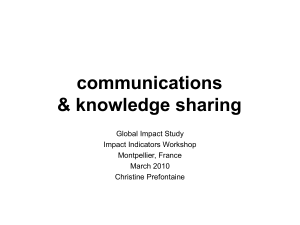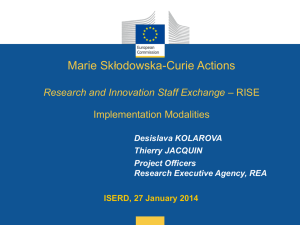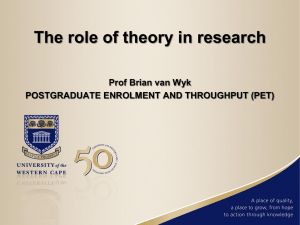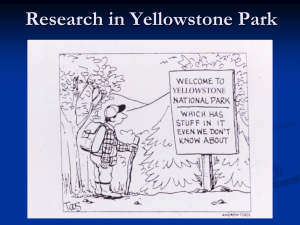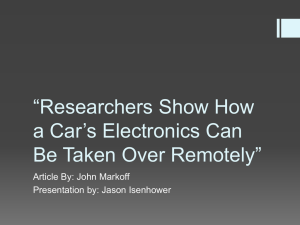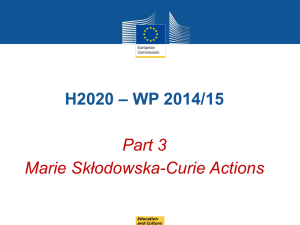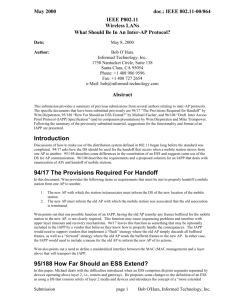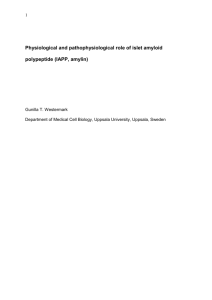Industry-Academia_Partnerships_and_Pathways_IAPP
advertisement
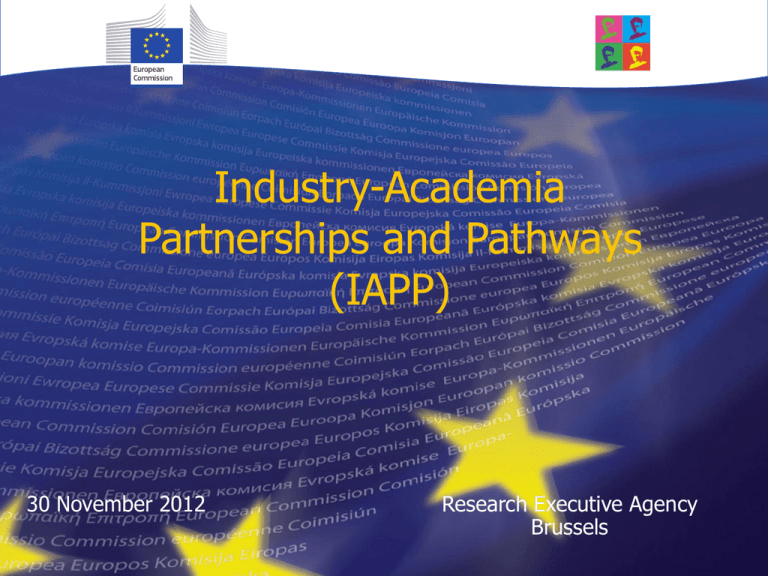
Industry-Academia Partnerships and Pathways (IAPP) 30 November 2012 Research Executive Agency Brussels IAPP 2013 Key documents for IAPP 2013 call PEOPLE Work Programme 2013 Guide for applicants – Common part – Ethics part – Specific part Participant Portal http://ec.europa.eu/research/participants/portal/pa ge/people?callIdentifier=FP7-PEOPLE-2013-IAPP IAPP Objectives • Foster co-operation between non-commercial research organisations & commercial enterprises based on joint research projects. • Stimulate long-term collaboration between sectors through secondment of researchers between the public & private research domains. • Diverse career possibilities & research experience for researchers, and support knowledge sharing/cultural exchange. IAPP consortium • At least 1 partner from non-commercial sector • At least 1 partner from commercial sector • Partners from at least 2 different MS or AC • Additional participants from anywhere in the world • Usually 2 to 6 participants and 48 months project IAPP Eligible Organisations • Non-Commercial organisations ("academia"): for the purposes of the IAPP action, research performing organisations not operating on a commercial basis. National organisations (e.g. universities, public non-commercial research centres etc.) Non-profit or charitable organisations (e.g. NGOs, trusts, etc.) International European interest organisations (e.g. CERN, EMBL, etc.) The Joint Research Centre of the European Commission International organisations (e.g. WHO, UNESCO, etc.) • Commercial participants ("industry"): for the purposes of the IAPP action, researchperforming enterprises, including SMEs, which gain the majority of their revenue through competitive means with exposure to commercial markets. Commercial enterprises of any size National organisations (if operating on a commercial basis) Eligible Country Groups • EU Member States (MS) • Associated Countries (AC): Albania, Bosnia and Herzegovina, Croatia, FYR Macedonia, Iceland, Israel, Liechtenstein, Montenegro, Moldova, Norway, Serbia, Switzerland, Turkey and Faroe Islands. • Other Third Countries (OTC), divided into: International Cooperation Partner Countries (ICPC) based on three categories according to income per capita (low-income, lower-middle-income, or upper-middleincome) High-income Third Countries (non-AC, non-ICPC) IAPP Main Activities Compulsory Staff Secondment • Majority of support in IAPP (≥ 50% of person-months) • Always inter-sector • Usually 2-way with reintegration phase (Min. reintegration period for seconded staff is now the same length as the total exchange duration. For secondments equal to or longer than one year, the reintegration period must be for at least 12 months) • Up to 30% intra-national secondments Optional Recruitment of experienced researchers • Relevance to project and to recruiting organisation shall be duly justified • Not a substitute for secondment (no recruitment inside the consortium) OtOther • Networking activities • Workshops & Conferences IAPP Main Activities Secondments ≥ Recruitments Non commercial sector secondments Intra-national secondment Commercial sector Coordinator UK Partner 3 MD Partner 2 TR max 30% recruitment Recruited researchers (optional and anyway≤ than secondments) Partner 4 MD Intra-national secondment Secondments in the same country between two different sectors can be allowed up to maximum 30% of total person months of the project Non commercial sector Partner 5 IT Commercial sector A Partner 6 IT Intra-national secondment Partner 3 MD B a + b 30% total person months Partner 4 MD Eligible researchers Eligible researchers Secondment • • • • • • Early-stage (ESR) or experienced researchers (ER, MER) Management & technical staff where justified No nationality restriction Wide advertisement of Staff members active for at least 1 year positions and an Mandatory return phase open & Mobility 2–24 months (split stays allowed) transparent Recruitment recruitment process • Experienced researchers only (ER, MER) • No nationality restriction • Transnational mobility: : recruited researchers must not have • resided (or carried out their main activity) in the country of the hosting institution for more than 12 months during the 36 months prior recruitment Employment contracts: 12–24 months ESR = research experience ≤ 4 years and no PhD ER = PhD or at least 4 years of research experience MER= more than 10 years of research experience Proposal structure Each proposal has two parts: • • Part A: administrative information about the applicants Part B: scientific and technical content of the proposal Proposals are evaluated on the content of Part B. It must include sufficient information regarding each criterion to be evaluated. Material such as web links is not taken into consideration. Eligible Page researchers limit Maximum length for B.2 – B.5 sections of Part B: • B.2 S&T Quality - 10 pages, • B.3 Transfer of Knowledge - 6 pages, • B.4 Implementation - 10 pages, • B.5 Impact - 4 pages Keep your proposal within these limits. Experts are instructed to disregard any excess pages in each section in which the maximum number of pages is indicated. General remarks When preparing your proposal pay attention to: • Consistency of n° of person months in Part A (Form A4) & Part B • Appropriate size of consortium • Including partners that have experience in managing FP7 projects increases the chances to obtain funding • Good operational and financial capacity of partners • All partners are research organisations • Focus on secondments • All secondments must take place between institutions which are fully independent of each other, including in terms of their financial resources and staffing • In case a consortium requests contribution to small equipment expenses for participating SMEs – remember to justify it in the proposal Evaluation criteria Eligible researchers Evaluation criteria Criterion 1 S&T •S&T objectives of the research programme, including in terms of intersectorial issues. •Scientific quality of the joint collaborative research programme. •Appropriateness of research methodology and approach. •Originality and innovative aspect of the research programme. Knowledge of the state-of-theart. Eligible researchers Evaluation criteria Criterion 2 ToK •Quality of the transfer of knowledge programme. Consistency with the research programme. •Importance of the transfer of knowledge in terms of intersectorial issues. •Adequacy of the role of researchers exchanged and recruited from outside the partnership with respect to the transfer of knowledge programme. Eligible researchers Evaluation criteria Criterion 3 Implementation • Capacities (expertise/ human resources/ facilities/ infrastructures) to achieve the research and exchange of know-how and experience. Fit between capacity of host and size of support requested. • Adequate exploitation of complementarities and synergies among partners in terms of transfer of knowledge. • Appropriateness of management plans (recruitment/secondment strategy, IPR strategy, demarcation of responsibilities, rules for decision making, etc…); also working conditions, transparency of recruitment process and career development.* • How essential is non-ICPC third country funding, if any, to the objectives of the research training programme. • In case of SMEs participation: Adequacy of the available infrastructures for the performance of the project. In case extra equipment is requested, necessity and justification in the Eligible researchers Evaluation criteria Criterion 4 Impact • Provision to develop new and lasting intersectoral collaborations. Extent to which SMEs contribute to the project, where appropriate. • Strategy for the dissemination and exploitation/commercialisation of the results. • Impact on the innovation potential of the European Research Area. In the relevant fields, description of potential applications. • Facilitation of sharing knowledge and culture between the participants and external researchers (including international conferences, workshops, training events).* • Impact of the proposed outreach activities.* Decimal scores can be used

